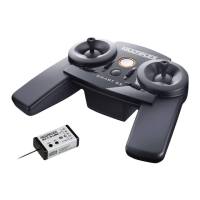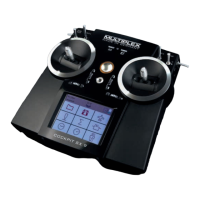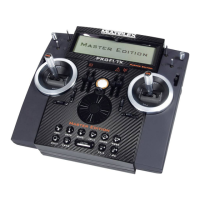Manual
35
e. Press ENTER to confirm the warning message:
Standard list!
The warning has to be confirmed because any
change affects all models which are set up using
the same assignment list (GLIDER).
The line in the menu must look like this:
Spoiler ‡ '
f. Now move the transmitter control to the desired
idle position; the arrow will change its direction
when you do this (' , #). The asterisk (*) is always
displayed.
g. Press the 3-D digi-adjuster or ENTER to confirm:
Spoiler ‡ #*
In our example the idle position for Spoiler is “stick
back”.
The idle position for Throttle can be changed in the
same manner.
For Flap (camber-changing flaps) there is no need to
change the idle position, as the deflection takes place
on both sides of centre.
12.3.2. Changing the switch ON position
The position of the “ON” state can be changed for all
switches which are used in an assignment list.
Example Combi-Switch (CS/DTC):
In the pre-defined assignment list GLIDER the Combi-
Switch is active when the switch N is in the “back” po-
sition. If you want the ON state to be “forward”, please
use this procedure:
a. Open the main menu ¡Setup (press button ¡).
b. Select (3-D digi-adjuster) and open (press the 3-D
digi-adjuster) the Assignment menu.
c. Select (3-D digi-adjuster) the sub-menu Switches
and open the setting (press the 3-D digi-adjuster).
d. Select (3-D digi-adjuster) and open (press 3-D digi-
adjuster) the switch CS/DTC.
e. Confirm the warning message: Standard list!
by pressing ENTER.
The warning has to be confirmed because any
change affects all models which are set up using
the same assignment list (GLIDER).
When switch N is forward, the line in the menu
must look like this:
CS/DTC <N '*
f. Now move the switch to your preferred position for
Combi-Switch “ON”. The arrow changes its direc-
tion (' , #). The asterisk (*) is always displayed.
g. Press the 3-D digi-adjuster or ENTER to confirm:
CS/DTC <N '*
12.4. Preparing servos
In this section the settings for the outboard wing flaps
are entered. The inner wing flaps are added in section
( 12.8.).
12.4.1. Checking / changing the servo assignment
At the servo assignment stage the following as-
pects are determined:
the receiver outputs to which the servos have to
be connected,
the signal format which the servos require (MPX
or UNI), and
the number of variable curve points (2, 3 or 5)
required for servo travel and centre calibration.
Note: defaults
In the 4 FLAPS template all the servos are set to the
UNI signal format and three (3) curve points by default.
This is the procedure:
a. Open the main menu ¤Servo (press button ¤).
b. Select (3-D digi-adjuster) and open (press 3-D digi-
adjuster) the menu Assignment.
c. In this menu the assignment for all receiver outputs
can be changed in any way you like.
In our example we will change servo 4 from Throt-
tle to Tow release (Tow rel.):
d. Select (3-D digi-adjuster) and open (press 3-D digi-
adjuster) Servo 4:
¤Servo.Assign
¨Exit
1 AILERON+ UNI 3P
2 ELEVATR+ UNI 3p
3 Rudder UNI 3P
4 Throttle UNI 3P
5 AILERON+ UNI 3P
ª6 FLAP+ UNI 3P
e. Select Tow rel. (3-D digi-adjuster) and move on
to Signal format (press 3-D digi-adjuster).
f. For example: if you are using a servo with MULTI-
PLEX signal format for the tow release, you can
switch to MPX (rotate 3-D digi-adjuster) at this
point.
4 Tow rel. UNI 3P
g. Move to the number of curve points (press the 3-D
digi-adjuster again):
4 Tow rel. UNI 2P
h. Two points (2P) are sufficient for the tow release,
since only the two end-points need to be adjusted.
A tow release is normally operated using a two-
position switch as transmitter control, since inter-
mediate positions would offer no advantage.
i. Press the 3-D digi-adjuster or ENTER to confirm.
The number 4 is highlighted, and you can now se-
lect a different servo:
4 Tow rel. UNI 2P

